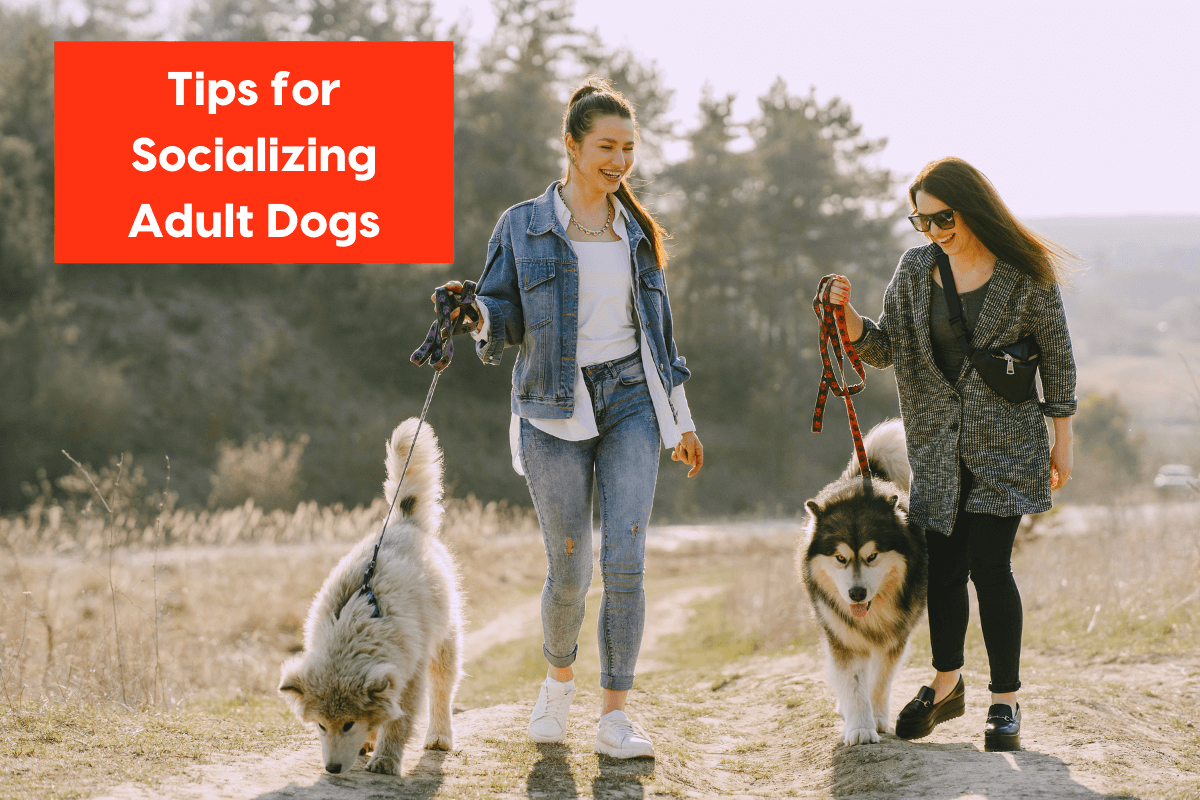Key Takeaways
Start socializing your dog as early as possible for the best results.
Socialization involves creating positive experiences with new people, dogs, and environments.
Adult dogs can still be socialized, but it requires more patience and consistency.
Watch your dog’s body language to ensure they are comfortable during socialization.
Poor socialization can lead to behavioral issues like fear and aggression.
Why Socialization is Crucial for Your Dog
Socialization is a vital aspect of a dog’s development. It involves exposing your dog to new people, other dogs, and various environments in a positive manner. This helps them learn how to behave appropriately and feel comfortable in different situations. A well-socialized dog is typically happier, more confident, and less likely to exhibit behavioral problems.
“Dog socialization is when a pet parent purposefully exposes a dog to unfamiliar people, dogs, and settings to get them used to the world around them.”
Without proper socialization, dogs can become fearful, anxious, or aggressive. These behaviors can make it challenging for you to take your dog out in public, have guests over, or even go for a simple walk. Therefore, ensuring your dog is well-socialized is not just beneficial for them, but also for you and everyone around you.
“How to Socialize an Adult Dog …” from pupford.com and used with no modifications.
Key Principles of Dog Socialization
To successfully socialize your dog, you need to follow a few key principles. First, always create positive associations with new experiences. This means rewarding your dog with treats, praise, or play whenever they encounter something new and respond calmly. Second, introduce new situations gradually. Don’t overwhelm your dog with too many new experiences at once. Finally, be patient and consistent. Socialization is a gradual process that requires time and dedication.
When to Start Socializing Your Dog
The ideal time to start socializing your dog is when they are a puppy, between seven weeks and four months old. During this period, puppies are more open to new experiences and less likely to be fearful. However, if you have an older dog that missed out on early socialization, don’t worry. It’s still possible to socialize an adult dog; it just takes a bit more effort and patience.
Start early: The best time to begin socialization is during the puppy stage.
Gradual exposure: Introduce new experiences slowly to avoid overwhelming your dog.
Positive reinforcement: Reward your dog for calm and positive behavior in new situations.
Socializing Puppies vs. Adult Dogs
Socializing puppies is generally easier because they are naturally more curious and open to new experiences. During the critical socialization period, puppies are more adaptable and less likely to develop fears. You can introduce them to a wide range of people, dogs, and environments, ensuring each experience is positive. For more tips, check out this guide on how to socialize your dog.
On the other hand, socializing an adult dog can be more challenging, especially if they have had negative experiences in the past. Adult dogs may be more set in their ways and can take longer to adjust to new situations. However, with patience, consistency, and positive reinforcement, even adult dogs can learn to be well-socialized. For instance, taking your dog to places like Riverfront Regional Park can provide a controlled environment to help them get used to new experiences.
Is it Ever Too Late to Socialize a Dog?
No, it’s never too late to socialize a dog. While it’s easier to socialize a puppy, adult dogs can still learn to be comfortable in new situations. The key is to take it slow and be patient. Start with less challenging environments and gradually increase the level of difficulty as your dog becomes more comfortable.
Remember, the goal is to create positive experiences. If your dog shows signs of fear or anxiety, take a step back and try a less challenging situation. Over time, your dog will build confidence and learn to enjoy new experiences.
Steps to Start Socializing Your Dog
Now that you understand the importance of socialization and when to start, let’s dive into the steps to properly socialize your dog. Whether you have a puppy or an adult dog, these steps will help you create positive experiences and build your dog’s confidence.
Creating Positive Associations
The foundation of socialization is creating positive associations with new experiences. This means rewarding your dog with treats, praise, or play whenever they encounter something new and respond calmly. Positive reinforcement helps your dog associate new experiences with good things, making them more likely to remain calm and relaxed in the future.
“To socialize an adult dog with other dogs, start by making seeing other dogs a positive experience. Offer a treat when you see another dog in the distance out on a walk—before your pup has a chance to react.”
Gradual Exposure to New Situations
When socializing your dog, it’s essential to introduce new situations gradually. Start with less challenging environments and slowly increase the level of difficulty as your dog becomes more comfortable. For example, begin by introducing your dog to a calm, friendly dog before taking them to a busy dog park.
Gradual exposure helps prevent your dog from becoming overwhelmed and allows them to build confidence at their own pace. Always pay attention to your dog’s body language and adjust the level of difficulty based on their comfort level.
Monitoring Your Dog’s Body Language
One of the most crucial aspects of socializing your dog is learning to read their body language. Dogs communicate their feelings through their posture, tail position, and facial expressions. By understanding these signals, you can gauge your dog’s comfort level and adjust the socialization process accordingly. For more insights on creating a pet-friendly environment, check out these pet-safe evergreen shrubs.
For instance, a relaxed dog typically has a loose, wagging tail and a soft, open mouth. In contrast, a dog that is anxious or scared may have a tucked tail, raised hackles, and a tense body. If you notice signs of stress, it’s essential to remove your dog from the situation and give them a break.
How to Help Your Dog Interact with Other Dogs
Helping your dog interact with other dogs can be one of the most rewarding aspects of socialization. However, it can also be one of the most challenging, especially if your dog is fearful or reactive. The key is to start slowly and create positive experiences with other dogs.
“Different dogs struggle with different aspects of socialization. For some, new places are the problem. Others might love people but have trouble with new dogs—or vice versa. And some pups don’t like all three.”
Here are some steps to help your dog interact with other dogs:
Start with controlled introductions: Begin by introducing your dog to another calm, friendly dog in a controlled environment, such as your backyard.
Use positive reinforcement: Reward your dog with treats and praise for calm behavior during interactions with other dogs.
Monitor body language: Pay close attention to your dog’s body language and intervene if you notice signs of stress or aggression.
Gradually increase exposure: As your dog becomes more comfortable, gradually introduce them to more dogs and different environments.
Introducing Your Dog to Other Dogs on Walks
Walks are an excellent opportunity to help your dog interact with other dogs. Start by walking your dog in a quiet area where you are likely to encounter only a few dogs. When you see another dog, offer your dog a treat and praise them for staying calm. Gradually decrease the distance between your dog and the other dog, always rewarding calm behavior.
Making Playdates with Friendly Dogs
Organizing playdates with friendly dogs is another effective way to socialize your dog. Choose dogs that are known to be calm and well-behaved. Initially, keep the playdates short and supervised to ensure both dogs are comfortable. Over time, you can increase the duration and allow the dogs more freedom to interact.
Visiting Dog Parks Safely
Dog parks can be a great place for socialization, but they can also be overwhelming for some dogs. Before visiting a dog park, make sure your dog is comfortable interacting with other dogs on walks and during playdates. Start by visiting the park during off-peak hours when it’s less crowded. Keep your dog on a leash initially and gradually allow them more freedom as they become more comfortable.
Always monitor your dog’s body language and be prepared to intervene if necessary. If your dog shows signs of stress or aggression, remove them from the situation and try again another day. For a great place to practice socializing, consider visiting Riverfront Regional Park.
Challenges in Dog Socialization and How to Overcome Them
Socializing your dog can come with its fair share of challenges. Some dogs may be fearful or anxious, while others may become over-excited or aggressive. Understanding these challenges and knowing how to address them is crucial for successful socialization.
Dealing with Fear and Anxiety
Fear and anxiety are common issues in dogs that have not been properly socialized. To help your dog overcome these feelings, start by exposing them to new experiences gradually. Use positive reinforcement to reward calm behavior and create a safe, supportive environment. For more tips, you can read about how to help an adult dog with socialization.
“Building new positive associations is a key part of how to socialize an adult or rescue dog.”
If your dog is particularly fearful, consider working with a professional dog trainer or behaviorist. They can provide you with additional strategies and support to help your dog build confidence.
Managing Over-Excitement
Some dogs may become overly excited during socialization, leading to hyperactive or even aggressive behavior. To manage over-excitement, practice basic obedience commands such as “sit,” “stay,” and “leave it.” These commands can help you regain control and redirect your dog’s energy.
Additionally, ensure your dog gets plenty of physical and mental exercise. A tired dog is less likely to become overly excited during socialization.
Potential Consequences of Poor Socialization
Poor socialization can have significant consequences for both your dog and you. Understanding these potential issues underscores the importance of proper socialization.
Behavioral Issues
Dogs that are not well-socialized are more likely to develop behavioral problems such as aggression, fearfulness, and anxiety. These issues can make it challenging to take your dog out in public or have guests over. In severe cases, poor socialization can lead to dangerous behaviors that put your dog and others at risk.
Impact on Dog’s Well-being
Socialization is essential for your dog’s mental and emotional well-being. Dogs that are not properly socialized may experience chronic stress and anxiety, which can negatively impact their overall health. A well-socialized dog is typically happier, more relaxed, and better able to cope with new experiences.
Consequences for Owners and Others
Poor socialization can also have consequences for you as the owner. It can limit your ability to take your dog out in public, participate in activities, and enjoy a fulfilling relationship with your pet. Additionally, poorly socialized dogs can pose a risk to other people and animals, leading to potential legal and financial issues.
Seeking Professional Assistance
If you’re struggling to socialize your dog, don’t hesitate to seek professional help. A certified dog trainer or behaviorist can provide you with the guidance and support you need to successfully socialize your dog.
When to Consult a Professional Trainer
Consider consulting a professional trainer if your dog exhibits severe fear, aggression, or other behavioral issues. A trainer can help you develop a customized socialization plan and provide you with the tools and techniques to address your dog’s specific needs. For instance, they may suggest visiting Washington Park for controlled socialization experiences.
Resources for Ongoing Support
There are many resources available to help you with dog socialization. Look for local training classes, online courses, and support groups. These resources can provide you with valuable information and connect you with other dog owners who are going through similar experiences.
When to Consult a Professional Trainer
If you find that your dog is showing severe fear, aggression, or other challenging behaviors despite your best efforts, it may be time to consult a professional trainer. These experts can provide you with a tailored socialization plan and offer techniques to address specific issues your dog may have.
“Working with a dog that has missed their early life socialization can be a daunting task, even if you’ve previously had and helped such dogs before. Every dog and every situation is different.”
Professional trainers have the experience and knowledge to handle various behavioral problems. They can also offer support and encouragement, making the socialization process less stressful for both you and your dog.
Resources for Ongoing Support
Socializing your dog is an ongoing process, and there are numerous resources available to help you along the way. Look for local dog training classes, online courses, and support groups where you can connect with other dog owners facing similar challenges.
Books, blogs, and videos by experienced trainers can also provide valuable insights and practical tips. Websites like the American Kennel Club (AKC) and the Association of Professional Dog Trainers (APDT) offer a wealth of information on dog behavior and training techniques.
Frequently Asked Questions (FAQ)
How long does it take to socialize a rescue dog?
The time it takes to socialize a rescue dog can vary widely depending on the dog’s age, background, and individual temperament. Some dogs may show improvement within a few weeks, while others may take several months to become fully comfortable in new situations. Patience and consistency are key. For example, places like Washington Park can provide a great environment for socialization.
Can an older rescue dog still learn to be socialized?
Yes, older rescue dogs can still learn to be socialized. While it may take more time and effort compared to socializing a puppy, adult dogs are capable of learning new behaviors and becoming comfortable in new environments. The process requires patience, positive reinforcement, and gradual exposure to new experiences.
What are some signs that my rescue dog is not well-socialized?
Signs that your rescue dog is not well-socialized may include:
Fear or anxiety around new people or dogs
Aggressive behavior such as growling or snapping
Excessive barking or lunging on walks
Refusal to enter new environments
Hiding or cowering in unfamiliar situations
How do I introduce my rescue dog to a new environment?
When introducing your rescue dog to a new environment, start with a calm and controlled setting. Allow your dog to explore at their own pace and use treats and praise to reward calm behavior. Gradually increase the level of difficulty as your dog becomes more comfortable. For example, you can take them to Washington Park for a gentle introduction to new surroundings.
For example, if you’re introducing your dog to a busy park, start by visiting during a quiet time and gradually work up to busier periods. Always monitor your dog’s body language and be prepared to remove them from the situation if they show signs of stress or anxiety.
In conclusion, socializing your dog is a crucial part of their development and well-being. Whether you have a puppy or an adult dog, the principles of creating positive associations, gradual exposure, and using positive reinforcement remain the same. By following these steps and seeking professional help when needed, you can help your dog become a well-adjusted and happy member of your family.






